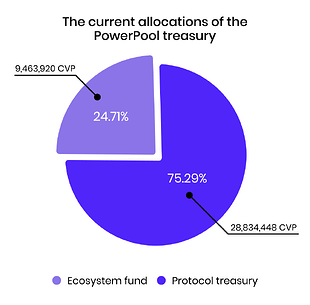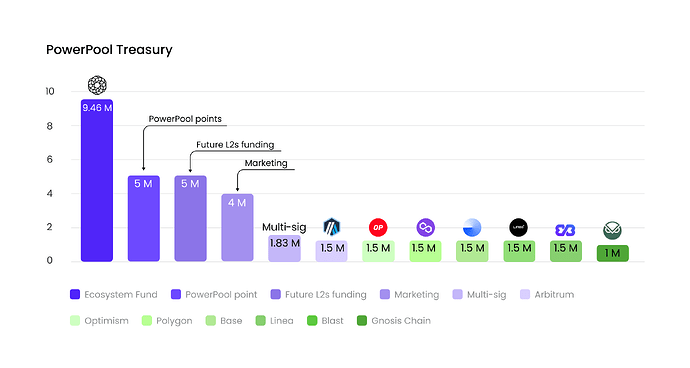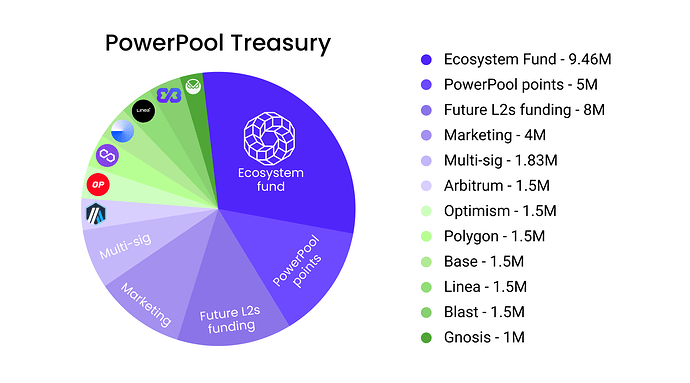Proposal 65: structure the PowerPool DAO treasury allocations
update (June 18, 2024) - The proposal number has been changed from 62 to 65 to maintain consistency in Snapshot voting
Summary
- The main share of the PowerPool DAO treasury (75.29%) still isn’t allocated
- The PowerPool growth plan includes a set of activities requiring funding, such as marketing, user acquisition, and chain-specific ecosystem growth
- The Treasury is proposed to be structured to fund specific activities according to growth goals. It includes Marketing, PowerPool Points, and a set of allocations dedicated to growing protocol brand and user base on emerging L2s
- The voting on this proposal results in determining treasury allocations and details of PowerPool DAO growth focus
Motivation
Background
From the PowerPool launch, the DAO treasury has been stored on the multi-sig [1]. Since then, it has been continuously used for various purposes according to the proposals approved by the community, such as
- funding liquidity mining programs [2],[3]
- paying out project expenses and rewarding DAO contributors [4]
- rewarding testnet participants and bug bounties [5]
- compensating the community members due to the BNB bridge termination CVP stuck [6]
- providing the token allocation for the core team [7]
- funding market-makers operations and providing CVP liquidity on CEXes [8]
- establishing the dedicated DAO funds (treasury allocations) such as the Ecosystem Growth Fund & Grants program (referred to as the Ecosystem Fund thereafter) [9]
All notable updates to token distributions have been reflected in the coinmarketcap/coingecko token trackers.
As per all previous DAO proposals, the community treasury is now held in the Multi-Sig (~28.83m $CVP) and the Ecosystem Fund (~9.46m $CVP):
Fig. 1. The current state of the PowerPool DAO treasury allocations.
This means that a significant share of the treasury, stored on multi-sig (28.8m $CVP), still hasn’t been allocated to any specific purpose.
PowerPool ecosystem expansion plans
PowerPool’s main product is PowerAgent, which the team has extensively tested and improved over the last 1.5 years with node runners’ community support.
PowerAgent has been positioned as the dePIN Keeper network offering Transaction Execution As a Service for users and protocols.
Now, PowerPool is expanding its vision beyond Transaction Execution as a Service, including automation powered by AI agents. The growth of the decentralized AI sector and the necessity to execute AI decisions (such as yield, trading strategies, and more) offers a significant expansion for PowerPool’s value proposition and future user base.
PowerPool allows users, protocols, and AI agent to automate daily Defi routine actions and tasks with complicated logic. It is being tested on Ethereum, Gnosis, Arbitrum, and Polygon Sepolia and was recently deployed on Base.
According to the published roadmap, PowerPool aims to deploy PowerAgent on all significant EVM-compatible chains and rollups, promote ecosystem growth, raise brand awareness, and acquire users/Keepers in various ecosystems.
According to the current state of the market, PowerPool needs to work even more on a significant expansion to the L2s, acquiring members from new communities via events/marketing/media/KOLs outreach, introducing the points system, and performing synergetic win-win integrations with Defi and AI protocols.
The ecosystem expansion plans should include the following:
- Deployment on Optimism, Scroll, Linea, zkSync, Blast, StarkNet, Avalanche, BNB Chain, NeonEVM, and other notable chains, including EVM-compatible Bitcoin L2s in the future
- Providing incentives (points and future token airdrops) to increase awareness and user base (including both keeper and job owner acquisition)
- Marketing activities, including media outreach, community campaigns, KOLs campaigns
- Participating in events and hackathons as co-hosts and bounty sponsors focused on chains where PowerAgent is deployed
- Establishing long-term partnerships with L1/L2 EVM-compatible ecosystems
- A significant amount of DevRel activities, AI protocols research/integration, and offering grants and other types of incentives for builders and protocols
Treasury utilization goals
Treasury should serve the protocol expansion in the web3 landscape with a focus on continuous growth of the following objective and subjective metrics:
- the overall brand awareness and brand value in the crypto community of developers and users
- number of L1/L2 ecosystems covered by PowerAgent network operation
- Chain-specific brand recognition as the automation infrastructure for end users, builders, and protocols
- the total number of users, Jobs, Jobs executions, and total value processed through the PowerAgent automation network
- the total size of a PowerAgent node runner community across different L1/L2s
- total number of automated products and templates built on top of PowerAgent, including AI-powered strategies
Motivation conclusion
The PowerPool treasury contains ~28.83 million $CVP that has not yet been allocated. The growth strategy and roadmap require significant funding for marketing activities and incentivizing various L2 chains.
In order to efficiently utilize the treasury, it should be specifically allocated to funding activities that grow the protocol metrics mentioned above.
For this purpose, we propose establishing an updated treasury structure according to the protocol expansion plans and growth strategy.
Specifications
We propose establishing a structure for the DAO treasury by funding processes that directly affect the growth of the protocol according to the expansion plan. They are listed below:
- Marketing activities focused on a growing overall brand awareness
- The points system, aimed at facilitating users acquisition
- The chain-specific growth funds, which will act as a universal funding pot for all actions needed to establish the PowerPool brand, grow the user base, and attract more builders to build on top of PowerPool on a specific chain, including AI-powered strategies
The PowerPool treasury is an Ecosystem Fund + multi-sig balances or approximately 38.29 million $CVP. The new treasury structure is proposed by distributing $CVP from multi-sig to allocation-specific multi-sigs while keeping the Ecosystem Fund allocation the same.
Proposed PowerPool DAO treasury allocation:
| Name | Goal | $CVP allocation | Share of treasury(rounded to 0.01) | |
|---|---|---|---|---|
| PPP (PowerPool Points) | User acquisition on various chains | 5,000,000 | 13.06% | |
| Marketing | Growing brand awareness through events, media publications, X (Twitter) campaigns, and other activities | 4,000,000 | 10.45% | |
| Arbitrum | Funding chain-specific growth activities | 1,500,000 | 3.92% | |
| Optimism | Funding chain-specific growth activities | 1,500,000 | 3.92% | |
| Polygon | Funding chain-specific growth activities | 1,500,000 | 3.92% | |
| Base | Funding chain-specific growth activities | 1,500,000 | 3.92% | |
| Linea | Funding chain-specific growth activities | 1,500,000 | 3.92% | |
| Blast | Funding chain-specific growth activities | 1,500,000 | 3.92% | |
| Gnosis | Funding chain-specific growth activities | 1,000,000 | 2.61% | |
| Future L2s funding | Reserved for the future L2s expansion | 8,000,000 | 20.90% | |
| Ecosystem Fund | Generalized purposes, including ecosystem growth, DAO expenses, rewarding contributors, etc | 9,463,920 | 24.70% | |
| Multi-sig | Treasury allocation for funding other activities | 1,834,448 | 4.78% |
Note that categories related to L2 funding include funding for AI-powered strategies and integrations on these chains.
The bar and pie charts represent the proposed treasury structure:
Fig. 2. The proposed structure of the PowerPool DAO treasury allocations (bar chart).
Fig. 3. The proposed structure of the PowerPool DAO treasury allocations (pie chart).
Technical details
The new treasury structure will be implemented by creating multi-sigs for all new allocations and funding those allocations from the original multi-sig. The updated supply information will be submitted to Coinmarketcap and Coingecko.
Tokens allocated to certain categories can be reallocated to others according to future governance proposals. This option would allow treasury funding to remain relevant to the market’s state.
Conclusion
The new structure of the PowerPool treasury aimed at funding active ecosystem growth according to the expanded dePIN automation narrative is proposed to the community. It includes specific allocations to fund marketing, user acquisition, and chain-specific activities focusing on Ethereum’s most emerging and growing L2s, including AI-powered strategies on these chains. It also includes reserves to fund general DAO expenses, PowerPool growth on new chains that will be prioritized later, and other activities. If the community approves the new treasury structure, the funds will be allocated to a set of multi-sigs according to the allocation structure presented in the specification section.


